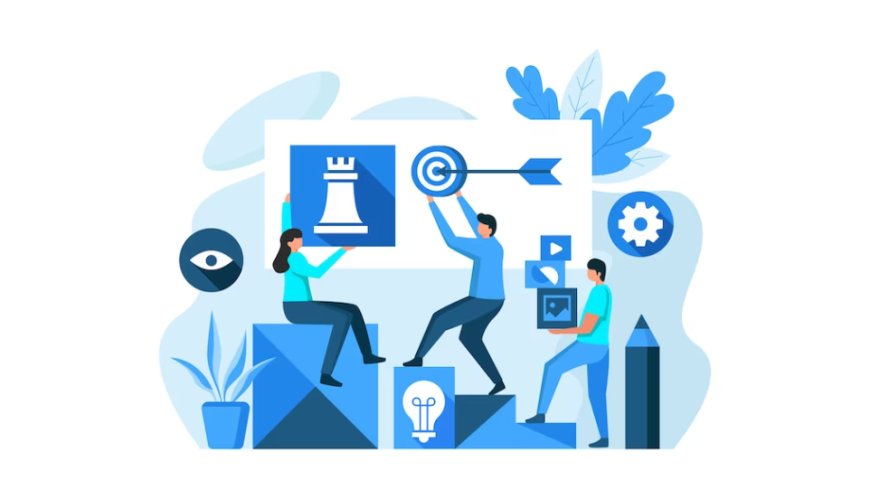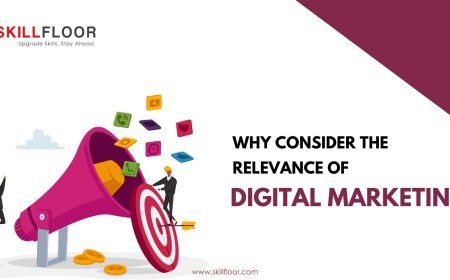The Future of Digital Marketing Creativity The Ever-Changing Landscape
Explore the ever-changing landscape of the future of digital marketing creativity. Discover key insights and trends shaping the digital marketing industry.

In the fast-paced world of digital marketing, the one constant that has always determined success is creativity. It's the spark that ignites compelling ad campaigns, viral social media content, and memorable brand experiences. But as we hurtle into an increasingly digital and data-driven future, the role of creativity in marketing is undergoing a transformation. The future of digital marketing creativity promises to be a dynamic fusion of art and science, where data and technology are harnessed to fuel imaginative, personalized, and immersive campaigns. In this era of constant change, understanding how creativity is evolving in the digital marketing landscape is not just a choice; it's a necessity for businesses looking to thrive and engage with their audiences in meaningful ways.
Personalization and Data-Driven Creativity
Personalization and data-driven creativity represent a seismic shift in the way businesses approach digital marketing. In the digital age, consumers are inundated with information and advertisements daily. To break through the noise and truly engage their audience, companies are increasingly turning to personalization and data-driven strategies. Here's a closer look at this transformative trend
Personalization's Power Personalization goes beyond simply addressing a customer by their first name in an email. It involves tailoring every aspect of a marketing campaign to an individual's preferences and behavior. This means delivering content, product recommendations and offers that are highly relevant to each customer. Personalization recognizes that not all customers are the same; they have unique interests, buying habits, and pain points. It's about providing a one-to-one marketing experience in a world where one-size-fits-all approaches no longer cut it.
Data-Driven Decision-Making Data is the lifeblood of personalization and data-driven creativity. Every interaction a customer has with a brand online generates valuable data, from website clicks and social media likes to purchase history and location data. Marketers can harness this information to gain insights into customer behavior and preferences. This data-driven approach enables businesses to make informed decisions about their marketing strategies. For example, if an e-commerce store sees that a particular segment of its customers frequently buys yoga gear, it can create targeted campaigns and content specifically for that audience.
Enhanced Customer Experience Personalization and data-driven creativity are not just about selling products; they're about enhancing the overall customer experience. When a customer feels that a brand understands their needs and consistently provides value, they're more likely to remain loyal and become brand advocates. Personalization can extend to the entire customer journey, from the moment a user lands on a website to post-purchase follow-ups. It can even encompass customer support interactions, where agents are armed with data to provide tailored solutions.
Interactive Content and Immersive Experiences
Interactive content and immersive experiences are transforming the way brands engage with their audiences in the digital marketing landscape. This concept goes beyond static text and images, offering users dynamic and engaging ways to interact with a brand's message or products.
One of the most significant aspects of interactive content is the integration of technologies like Augmented Reality (AR) and Virtual Reality (VR). AR overlays digital information or elements onto the real world, often through smartphone apps, while VR immerses users in entirely digital environments through specialized headsets. For instance, furniture retailers can now offer customers the ability to visualize how a new sofa might look in their living room using AR, or travel agencies can provide virtual tours of exotic destinations through VR. These technologies create a sense of immersion and personal connection that was previously unattainable through traditional marketing channels.
Immersive experiences also extend to interactive videos and 360-degree content. Interactive videos allow viewers to make choices that affect the storyline or outcome, making the content more engaging and personalized. Meanwhile, 360-degree content, which can be viewed by dragging or tilting a smartphone or using a VR headset, provides a unique perspective and a heightened sense of presence. This can be particularly powerful for showcasing products or locations.
The appeal of interactive content and immersive experiences lies in their ability to captivate and hold the audience's attention. They create a sense of novelty and excitement, encouraging users to spend more time with the brand's content. Moreover, by allowing users to actively participate in the experience, these techniques foster a deeper emotional connection, which can lead to increased brand loyalty and conversion rates.
Voice Search and Conversational Marketing
Voice search and conversational marketing are two interrelated concepts that have gained significant prominence in the digital marketing landscape in recent years. They both revolve around the idea of adapting marketing strategies to the way people use voice-activated technologies and virtual assistants to interact with the digital world.
-
Voice Search
Voice search is a technology that allows users to perform internet searches, access information, and execute tasks on their devices simply by using their voice. Popular virtual assistants like Siri, Google Assistant, and Amazon's Alexa have made voice search a common part of our daily lives. Rather than typing queries into a search engine, users can now ask questions or give commands verbally. This shift has major implications for digital marketing, as it requires marketers to optimize their content for voice search. This involves understanding how users frame voice queries (which tend to be more conversational and natural) and tailoring content to provide direct and concise answers.
-
Conversational Marketing
Conversational marketing is a strategy that prioritizes real-time, one-on-one connections with customers, often facilitated by chatbots, live chat, and messaging apps. The key principle is to engage customers in natural, meaningful conversations throughout their customer journey. When applied to voice search, conversational marketing takes on a new dimension. Marketers use conversational interfaces to interact with customers through voice-activated devices, answering questions, providing product recommendations, and even completing purchases. This approach seeks to replicate the experience of speaking with a knowledgeable salesperson in a physical store but in the digital realm.
AI-Generated Content
AI-generated content refers to text, images, videos, or other forms of creative content that are produced with the assistance of artificial intelligence (AI) technologies. AI-generated content is created by algorithms and computer programs rather than human beings. This emerging field is rapidly evolving and has the potential to revolutionize various industries, including marketing, journalism, entertainment, and more. Here's a more detailed explanation of AI-generated content:
-
Natural Language Generation (NLG): NLG is a subfield of AI that focuses on generating human-like text. AI algorithms can analyze data, understand patterns, and produce coherent and contextually relevant written content. For example, AI can be used to automate the creation of news articles, product descriptions, and even personalized marketing emails.
-
Image and Video Generation: AI can also generate visual content, such as images and videos. Generative Adversarial Networks (GANs) are a type of AI model that can create realistic images and videos by learning from large datasets. This technology is used in applications like deepfake videos, where AI can swap faces in videos or create entirely synthetic videos and images.
-
Content Personalization: AI can analyze user data and preferences to generate personalized content tailored to individual users. For instance, streaming platforms like Netflix use AI to recommend movies and TV shows based on a user's viewing history.
-
Chatbots and Virtual Assistants: Chatbots and virtual assistants use AI to generate conversational responses. They can answer questions, provide information, and even engage in natural language conversations with users. This is commonly used in customer support and e-commerce.
-
Content Enhancement: AI tools can be used to enhance existing content. For example, AI-powered editing tools can improve the quality of photos, videos, or written content. They can also translate content between languages or generate alternative versions of content.
Sustainability and Purpose-Driven Marketing
In recent years, sustainability and purpose-driven marketing have emerged as powerful strategies for businesses to connect with consumers, create a positive impact, and differentiate themselves in a crowded marketplace. Let's delve into what these concepts entail and why they have become essential in modern marketing.
Sustainability in Marketing
-
Environmental Responsibility: Sustainability in marketing refers to a commitment to minimizing the environmental impact of a company's operations and products. This includes reducing carbon emissions, conserving resources, and minimizing waste. Brands that embrace sustainable practices often showcase their efforts through marketing campaigns to appeal to eco-conscious consumers.
-
Ethical Sourcing and Production: Sustainable marketing also encompasses responsible sourcing of materials and ethical production processes. Companies may highlight their use of eco-friendly materials or fair labor practices in their marketing to demonstrate their commitment to sustainability.
-
Transparency: Transparency is a key component of sustainable marketing. Brands are increasingly expected to be open about their sustainability initiatives, sharing information about their environmental goals, progress, and challenges. This transparency builds trust with consumers who seek authenticity in their purchasing decisions.
Purpose-Driven Marketing
-
Defining a Brand's Purpose: Purpose-driven marketing revolves around a brand's commitment to a higher mission beyond profit. This purpose can be social, environmental, or community-oriented. It often involves identifying a societal issue or cause that aligns with the company's values and mission.
-
Creating Meaningful Impact: Purpose-driven marketing goes beyond surface-level commitments. It involves taking concrete actions to address the chosen cause, whether it's donating a portion of profits to a charity, launching initiatives to support underprivileged communities, or actively working to solve a social or environmental problem.
-
Authenticity: Authenticity is crucial in purpose-driven marketing. Consumers are quick to spot insincere or opportunistic efforts. To succeed, brands must genuinely embrace their chosen cause and integrate it into their core business practices.
Why Sustainability and Purpose-Driven Marketing Matter
-
Consumer Expectations: Modern consumers are increasingly conscious of the social and environmental impacts of their purchases. They prefer to support brands that share their values and actively contribute to making the world a better place. Sustainability and purpose-driven marketing provide a means for brands to align with these expectations.
-
Competitive Advantage: Companies that commit to sustainability and purpose-driven initiatives often gain a competitive advantage. These initiatives can help differentiate a brand in a crowded marketplace and attract a loyal customer base that values the brand's commitment to the greater good.
-
Long-Term Viability: Sustainability isn't just about appealing to today's consumers; it's about ensuring the long-term viability of a business. Responsible practices help companies reduce operational costs, adapt to changing regulations, and mitigate risks associated with environmental and social issues.
The future of digital marketing creativity is exciting and full of opportunities. To succeed, businesses must embrace data-driven personalization, explore immersive experiences, encourage user-generated content, adapt to voice search, leverage AI, prioritize sustainability, and master micro-moments. Creativity will remain the linchpin in all these endeavors, driving engagement, building trust, and delivering results in an ever-changing digital landscape. By staying agile and innovative, businesses can ensure that they are at the forefront of this creative revolution in digital marketing.




























































